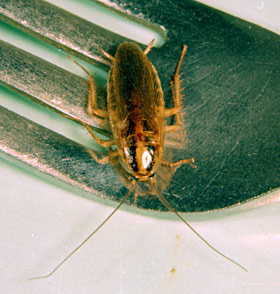German Cockroach, Blattella germanica

Clemson University - USDA Cooperative Extension Slide Series, Bugwood.org.
IPM Steps to Reduce German Cockroaches
1. Sample for Pest
Cockroaches can contaminate food, transmit disease and cause allergies. You can reduce the chance of having cockroaches and if you see one, you need to act now.
Where to find it while inspecting: You will need a strong flashlight, and a inspection size mirror (small and on a stick) is needed to do a good job of inspection. Draw a diagram map of the area. To monitor activity, you can place sticky traps in areas where you suspect activity. It’s a good idea to mark the date you set the trap and also to note the location on your map. You are most likely to find German cockroaches in the kitchen. Look under and behind sinks, appliances and in the areas of your cupboards shaded from light (also drawers, drop ceilings, the back of refrigerators, etc.) Check drains and any pipes, utility boxes and along the foundation. Check the traps (HOW OFTEN / FOR HOW LONG>?) You will also see “pepper-like” specks on walls near nest sites (feces).
2. Proper ID
Before you act, determine your pest is a cockroach and for best results, which species of cockroach.
Size and Appearance: Flattened, oval shaped insects with long legs and antennae, and wings (though German Cockroaches don’t fly). 1/2" brown adults, nymphs are smaller and wingless. Two dark stripes on head.
3. Learn the Pest Biology
Knowing the life cycle helps you fight cockroach infestations.
Life Cycle: German cockroaches produce large numbers of eggs and have the shortest time from hatch to sexual maturity. Females carry egg capsules until a day or two before they hatch. The egg capsule is a purse-shaped light yellow to light brown capsule containing 30–48 eggs. Females produce a new capsule every 6 wks. Once hatched, the nymphs grow over a period of 6–31 weeks depending on conditions (this is 6–7 nymphal instars).
Preferred Food Sources: Cockroaches are scavengers and will succeed in any warm, moist area that provides foods such as starches, sweets, grease and meats, but settle for garbage as well.
Preferred Habitat: German cockroaches need moisture and relative warmth. They are active at night and during the day will seek out dark sites such as cracks or crevices to hide in.
4. Determine Threshold
If you have cockroaches, you need to act.
Threshold: One cockroach almost always means more are unseen.
5. Choose Tactics
IPM for indoor pests is always a combination of exclusion and sanitation: Try to keep them out. Don’t provide water, food and shelter if they enter your building.
Best Management Practices: The key factor is sanitation and reduction in habitat—especially blocking access to a water source. Take care not to bring them in on packaging material (inspect incoming food and packaging materials). Clean up all spilled foods; don’t leave dirty dishes overnight; store all food in pest-resistant packaging; modify areas where pipes and utilities enter walls (caulk and screen all entrances); reduce moisture by improving plumbing and insulating pipes that routinely sweat. Empty garbage every day. Increase ventilation to damp areas. Baits are the most efficient and widely used form of control, but prevention is the least toxic method of control and no treatment will succeed if habitat issues are not taken care of.
Treatment Methods: Chemical control: Baits contain hydramethylnon, fipronil, sulfluramide, boric acid and abamectin can provide acceptable control. Read the label carefully before using and keep out of reach of children. Insecticidal dusts like boric acid, silica aerogel and diatomaceous can also provide control. Light applications of dust in cracks and crevices can be made, but not in areas where children have access. Baits kill actively feeding nymphs and adults but not eggs so this method will have to be maintained over a period of time. Bait failure can occur if baits are not replaced often enough or are not numerous enough to match the infestation. NOTE: the use of insecticide sprays and foggers is rarely effective NOTE: boric acid can be a hazard to children if within their reach. FOLLOW all precautions and regulations in your district.
6. Evaluate
Was the tactic successful? Record the date pests were first noted, and the tactic you used, and its success. Use one of our RECORD KEEPING tools.
For More Information:
Penn State Entomological Notes: German Cockroaches (PDF)
Penn Stated Extension Fact Sheets: German Cockroach
Maine School Pest Solutions: Cockroaches (PDF)
Main.gov Got Pests?: Cockroaches
IPM Workbook for New York State Schools (1 MB PDF)
Integrated Pest Management for Northeast Schools (1.8 MB PDF)
Found a Cockroach? Saw a Gazillion?
Remember:
When a pesticide application is necessary, all necessary and required precautions are taken to minimize risk to people and the environment and to minimize risk of pesticide resistance or pest resurgence. Pesticide use in your school may be prohibited or regulated by local policies or state and federal regulations. Risk reduction methods can include, but are not limited to, spot-treatment, the use of gel or paste bait formulations placed in inaccessible locations, injection into a crack or crevice, and other methods that reduce potential exposure.